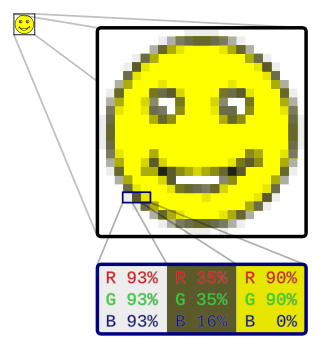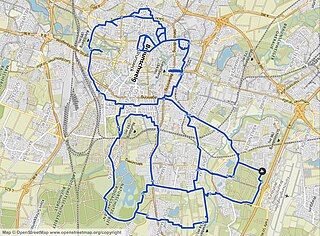
In computer graphics and digital photography, a raster graphics represents a two-dimensional picture as a rectangular matrix or grid of square pixels, viewable via a computer display, paper, or other display medium. A raster is technically characterized by the width and height of the image in pixels and by the number of bits per pixel. Raster images are stored in image files with varying dissemination, production, generation, and acquisition formats.
Word games are spoken, board, card or video games often designed to test ability with language or to explore its properties.

A crossword puzzle is a popular word game that typically consists of a square or rectangular grid of black and white squares. The objective is to fill the white squares with letters, forming words or phrases that intersect with each other. Players solve clues to find the correct answers. In languages written from left to right, the answer words and phrases are placed in the grid horizontally (“across”) and vertically (“down”). The shaded squares are used to separate the words or phrases.

A cryptic crossword is a crossword puzzle in which each clue is a word puzzle. Cryptic crosswords are particularly popular in the United Kingdom, where they originated, as well as Ireland, Israel, the Netherlands, and in several Commonwealth nations, including Australia, Canada, India, Kenya, Malta, New Zealand, and South Africa. Compilers of cryptic crosswords are commonly called "setters" in the UK and "constructors" in the US. Particularly in the UK, a distinction may be made between cryptics and "quick" crosswords, and sometimes two sets of clues are given for a single puzzle grid.
A puzzle is a game, problem, or toy that tests a person's ingenuity or knowledge. In a puzzle, the solver is expected to put pieces together in a logical way, in order to arrive at the correct or fun solution of the puzzle. There are different genres of puzzles, such as crossword puzzles, word-search puzzles, number puzzles, relational puzzles, and logic puzzles. The academic study of puzzles is called enigmatology.

A jigsaw puzzle is a tiling puzzle that requires the assembly of often irregularly shaped interlocking and mosaicked pieces, each of which typically has a portion of a picture. When assembled, the puzzle pieces produce a complete picture.

Nonograms, also known as Hanjie, Paint by Numbers, Picross, Griddlers, and Pic-a-Pix, and by various other names, are picture logic puzzles in which cells in a grid must be colored or left blank according to numbers at the side of the grid to reveal a hidden pixel art-like picture. In this puzzle type, the numbers are a form of discrete tomography that measures how many unbroken lines of filled-in squares there are in any given row or column. For example, a clue of "4 8 3" would mean there are sets of four, eight, and three filled squares, in that order, with at least one blank square between successive sets.
The MIT Mystery Hunt is an annual puzzlehunt competition at the Massachusetts Institute of Technology in Cambridge, Massachusetts. It is one of the oldest and most complex puzzlehunts in the world and attracts roughly 120 teams and 3,000 contestants annually in teams of 5 to 150 people. It has inspired similar competitions at Microsoft, Stanford University, Melbourne University, University of South Carolina, University of Illinois at Urbana–Champaign and University of Aveiro (Portugal) as well as in the Seattle, San Francisco, Miami, Washington, D.C., Indianapolis and Columbus, Ohio metropolitan areas. Because the puzzle solutions often require knowledge of esoteric and eclectic topics, the hunt is sometimes used to exemplify popular stereotypes of MIT students.

Kakuro or Kakkuro or Kakoro is a kind of logic puzzle that is often referred to as a mathematical transliteration of the crossword. Kakuro puzzles are regular features in many math-and-logic puzzle publications across the world. In 1966, Canadian Jacob E. Funk, an employee of Dell Magazines, came up with the original English name Cross Sums and other names such as Cross Addition have also been used, but the Japanese name Kakuro, abbreviation of Japanese kasan kurosu, seems to have gained general acceptance and the puzzles appear to be titled this way now in most publications. The popularity of Kakuro in Japan is immense, second only to Sudoku among Nikoli's famed logic-puzzle offerings.

Anticipation is a video board game developed by Rare and released by Nintendo for the Nintendo Entertainment System (NES) in 1988. It is playable in either single-player or multiplayer mode, with up to four players competing against each other and/or computer-controlled opponents.

GPS drawing, also known as GPS art, is a method of drawing where an artist uses a Global Positioning System (GPS) device and follows a pre-planned route to create a large-scale picture or pattern. The .GPX data file recorded during the drawing process is then visualised, usually overlaying it as a line on a map of the area. Artists usually run or cycle the route—while cars, vans, boats and aeroplanes are utilized to create larger pieces.
Nikoli Co., Ltd. is a Japanese publisher that specializes in games and, especially, logic puzzles. Nikoli is also the nickname of a quarterly magazine issued by the company in Tokyo. Nikoli was established in 1980 and became prominent worldwide with the popularity of Sudoku.

Fill-Ins, also known as Fill-It-Ins or Word Fill-Ins, are a variation of the common crossword puzzle in which words, rather than clues, are given, and the solver must work out where to place them. Fill-Ins are common in puzzle magazines along with word searches, cryptograms, and other logic puzzles. Some people consider Fill-Ins to be an easier version of the crossword. Since the Fill-In requires no outside knowledge of specific subjects, one can solve the puzzle in another language.

A sliding puzzle, sliding block puzzle, or sliding tile puzzle is a combination puzzle that challenges a player to slide pieces along certain routes to establish a certain end-configuration. The pieces to be moved may consist of simple shapes, or they may be imprinted with colours, patterns, sections of a larger picture, numbers, or letters.
Games World of Puzzles is an American games and puzzle magazine. Originally the merger of two other puzzle magazines spun off from its parent publication Games magazine in the early 1990s, Games World of Puzzles was reunited with Games in October 2014.
A metapuzzle, also known as a meta-puzzle or meta, is a puzzle that uses the solutions to a set of puzzles to create or provide data for a final puzzle.

Slitherlink is a logic puzzle developed by publisher Nikoli.
The New York Times crossword puzzle is a daily American-style crossword puzzle published in The New York Times, online on the newspaper's website, syndicated to more than 300 other newspapers and journals, and on mobile apps.

Only Connect is a British television quiz show presented by Victoria Coren Mitchell. In the series, teams compete in a tournament of finding connections between seemingly unrelated clues. The title is taken from a passage in E. M. Forster's 1910 novel Howards End: "Only connect the prose and the passion, and both will be exalted".

Cicada 3301 is a nickname given to three sets of puzzles posted under the name "3301" online between 2012 and 2014. The first puzzle started on January 2, 2012, on 4chan and ran for nearly a month. A second round of puzzles began one year later on January 4, 2013, and then a third round following the confirmation of a fresh clue posted on Twitter on January 4, 2014. The third puzzle has yet to be solved. The stated intent was to recruit "intelligent individuals" by presenting a series of puzzles to be solved; no new puzzles were published on January 4, 2015. A new clue was posted on Twitter on January 5, 2016. Cicada 3301 posted their last verified OpenPGP-signed message in April 2017, denying the validity of any unsigned puzzle.














